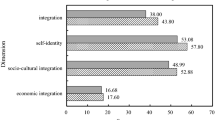Abstract
As urbanization rates rise globally, it becomes increasingly important to understand the factors associated with urban out-migration. In this paper, we examine the drivers of urban out-migration among young adults in two medium-sized cities in the Brazilian Amazon—Altamira and Santarém—focusing on the roles of social capital, human capital, and socioeconomic deprivation. Using household survey data from 1,293 individuals in the two cities, we employ an event history model to assess factors associated with migration and a binary logit model to understand factors associated with remitting behavior. We find that in Altamira, migration tends to be an individual-level opportunistic strategy fostered by extra-local family networks, while in Santarém, migration tends to be a household-level strategy driven by socioeconomic deprivation and accompanied by remittances. These results indicate that urban out-migration in Brazil is a diverse social process, and that the relative roles of extra-local networks versus economic need can function quite differently between geographically proximate but historically and socioeconomically distinct cities.


Similar content being viewed by others

Notes
We used the size of the tracts (as well as tract boundaries) from the 2007 population count. This count is an intercensal count of population that applies a short-form survey to all households to describe the population of the country and its administrative units on size and a limited set of characteristics (IBGE 2007).
Only two international migrants were observed in our sample. These were excluded from the analysis.
We estimated alternative models using the earliest year in which any parent arrived and using the latest year in which any parent arrived. Substantive results did not change.
We estimated alternative models using the highest education completed by either parent and using the lowest education completed by either parent. Substantive results did not change.
References
Alonso, S. & Castro, E. (2005). The process of transformation of rural areas into urban areas in Altamira and its representation. In Small and medium size cities. Lima: Instituto del Bien Comun.
Amorim, A. T. d. S. (2000). Santarém : uma síntese histórica [Santarém: a historical synthesis]. Canoas, RS: Editoria da ULBRA.
Arruda, H. P. d. (1978). Colonização official e particular. Rio de Janeiro: Instituto Nacional de Colonização e Reforma Agrária.
Barbieri, A. F., Carr, D. L., & Bilsborrow, R. E. (2009). Migration within the frontier: The second generation colonization in the Ecuadorian Amazon. Population Research and Policy Review, 28(3), 291–320.
Barros, R., Fox, L., & Mendonca, R. (1997). Female-headed households, poverty, and the welfare of children in urban Brazil. Economic Development and Cultural Change, 45(2), 231–257.
Browder, J. O., & Godfrey, B. J. (1990). Frontier urbanization in the Brazilian Amazon: A theoretical framework for urban transition. Yearbook. Conference of Latin Americanist Geographers, 56–66.
Browder, J. O., & Godfrey, B. J. (1997). Rainforest cities: Urbanization, development, and globalization of the Brazilian Amazon. New York: Columbia University Press.
Cerrutti, M., & Massey, D. S. (2001). On the auspices of female migration from Mexico to the United States. Demography, 38(2), 187–200.
Cohen, B. (2006). Urbanization in developing countries: Current trends, future projections, and key challenges for sustainability. Technology in Society, 28(1–2), 63–80.
Comissão Executiva do Plano da Lavoura Cacaueira (CEPLAC) (2009). O Estado do Pará e a produção Brasileira de cacau. http://www.ceplacpa.gov.br/site/?p=3009. Accessed January 21, 2013.
Confederação Nacional de Municípios (2011). Histórico Altamira, Pará. http://www.altamira.pa.cnm.org.br/portal1/municipio/historia.asp?iIdMun=100115009. Accessed May 9, 2011.
Costa, S. M. F., & Brondizio, E. (2009). Inter-urban dependency among Amazonian cities: Urban growth, infrastructure deficiencies, and socio-demographic networks. Redes, 14(3), 211–234.
DaVanzo, J. (1981). Repeat migration, information costs, and location-specific capital. Population and Environment, 4(1), 45–73.
Davis, B., Stecklov, G., & Winters, P. (2002). Domestic and international migration from rural Mexico: Disaggregating the effects of network structure and composition. Population Studies, 56(3), 291–309.
de la Rocha, M. G., & Gantt, B. B. (1995). The urban family and poverty in Latin America. Latin American Perspectives, 22(2), 12–31.
de Sá, M. E. R., da Costa, S. M. G., & de Oliveira Tavares, L. P. (2006). O rural-urbano em Santarém: Interfaces e territórios produtivos. In Ana Claudia Duarte Cardoso (Ed.), O rural e o urbano na Amazônia: Diferentes olhares em perspectivas. Belém: EDUFPA.
Deléchat, C. (2001). International migration dynamics: The role of experience and social networks. Labour, 15(3), 457–486.
Fearnside, P. M. (1984). Brazil’s Amazon settlement schemes: Conflicting objectives and human carrying capacity. Habitat International, 8(1), 45–61.
Fussell, E., & Massey, D. S. (2004). The limits to cumulative causation: International migration from Mexican urban areas. Demography, 41(1), 151–171.
Garip, F. (2008). Social capital and migration: How do similar resources lead to divergent outcomes? Demography, 45(3), 591–617.
Grandin, G. (2009). Fordlandia: The rise and fall of Henry Ford’s forgotten jungle city. New York: Macmillan.
Herrera, J. A., & Moreira, R. P. (2013). Restistência e confltos sociais na Amazônia Paraense: A luta contra o empreendimento Hidrelétrico de Belo Monte. Campo-Território, 8, 130–151.
Hoddinott, J. (1994). A model of migration and remittances applied to Western Kenya. Oxford Economic Papers, 46(3), 459–476.
IBGE. (2007). Contagem população 2007. Rio de Janeiro: Instituto Brasileiro de Geografia e Estatística.
IBGE. (2011). Cidades—Para. http://ibge.gov.br/cidadesat/topwindow.htm?1. Accessed May 9, 2011.
IBGE. (2012). Brazil demographic census 2010. Rio de Janeiro: Instituto Brasileiro de Geografia e Estatística (IBGE).
IBGE. (2014). Estados—Pará. http://www.ibge.gov.br/estadosat/perfil.php?sigla=pa. Accessed April 9, 2014.
Kanaiaupuni, S. M. (2000). Reframing the migration question: An analysis of men, women, and gender in Mexico. Social Forces, 78(4), 1311–1347.
Massey, D. S. (1987). Understanding Mexican migration to the United States. American Journal of Sociology, 92(6), 1372–1403.
Massey, D. S. (1990). Social structure, household strategies, and the cumulative causation of migration. Population Index, 56(1), 3–26.
Massey, D. S., Arango, J., Hugo, G., Kouaouci, A., Pellegrino, A., & Taylor, J. E. (1993). Theories of international migration: A review and appraisal. Population and Development Review, 19(3), 431–466.
Massey, D. S., & Aysa, M. (2005). Social capital and international migration from Latin America. Paper presented at Expert Group Meeting on International Migration and Development in Latin America and the Caribbean, Mexico City.
Massey, D. S., & García España, F. (1987). The social process of international migration. Science, 237(4816), 733–738.
McKenzie, D., & Rapoport, H. (2007). Network effects and the dynamics of migration and inequality: Theory and evidence from Mexico. Journal of Development Economics, 84(1), 1–24.
Moran, E. (1981). Developing the Amazon. Bloomington: Indiana University Press.
Musgrove, P. (1980). Household size and composition, employment, and poverty in urban Latin America. Economic Development and Cultural Change, 28(2), 249–266.
Osili, U. O. (2007). Remittances and savings from international migration: Theory and evidence using a matched sample. Journal of Development Economics, 83(2), 446–465.
Palloni, A., Massey, D., Ceballos, M., Espinosa, K., & Spittel, M. (2001). Social capital and international migration: A test using information on family networks. American Journal of Sociology, 106(5), 1262–1298.
Perz, S. G. (2002). Population growth and net migration in the Brazilian Legal Amazon, 1970–1996. In C. H. Wood & R. Porro (Eds.), Deforestation and land use in the Amazon (pp. 107–129). Gainesville: University Press of Florida.
Perz, S. G., Leite, F., Simmons, C., Walker, R., Aldrich, S., & Caldas, M. (2010). Intraregional migration, direct action land reform, and new land settlements in the Brazilian Amazon. Bulletin of Latin American Research, 29(4), 459–476.
Prefeitura de Santarém (2012). Histórico do município. http://www.santarem.pa.gov.br/conteudo/?item=121&fa=60. Accessed July 26, 2012.
Prefeitura de Santarém (2013). Ciclos econômicos. http://www.santarem.pa.gov.br/conteudo/?item=114&fa=61. Accessed January 21, 2013.
Reed, H. E., Andrzejewski, C. S., & White, M. J. (2010). Men’s and women’s migration in coastal Ghana: An event history analysis. Demographic Research, 22(25), 771–812.
Rose, N. (1980). A persisting misconception about the drought of 1958 in northeast Brazil. Climatic Change, 2(3), 299–301.
Rose, D., & Charlton, K. E. (2002). Prevalence of household food poverty in South Africa: Results from a large, nationally representative survey. Public Health Nutrition, 5(03), 383–389.
Russell, J. A. (1942). Fordlandia and Belterra, rubber plantations on the Tapajos River. Economic Geography, 18, 125–145.
Sana, M., & Massey, D. S. (2005). Household composition, family migration, and community context: Migrant remittances in four countries. Social Science Quarterly, 86(2), 509–528.
Shefer, D., & Steinvortz, L. (1993). Rural-to-urban and urban-to-urban migration patterns in Colombia. Habitat International, 17(1), 133–150.
Sjaastad, L. A. (1962). The costs and returns of human migration. The Journal of Political Economy, 70(5), 80–93.
Stark, O., & Bloom, D. E. (1985). The new economics of labour migration. American Economic Review, 75(1), 191–196.
Stark, O., & Lucas, R. E. B. (1988). Migration, remittances, and the family. Economic Development and Cultural Change, 36(3), 465–481.
Taylor, E. J. (1999). The new economics of labour migration and the role of remittances in the migration process. International Migration, 37(1), 63–88.
Taylor, J. E., & Martin, P. L. (2001). Human capital: Migration and rural population change. Handbook of Agricultural Economics, 1(A), 457–511.
Todaro, M. P. (1969). A model of labor migration and urban unemployment in less developed countries. The American Economic Review, 59(1), 138–148.
Umbuzeiro, A., & Umbuzeiro, U. (2012). Altamira e sua História. Belém: Ponto Press Ltda.
VanWey, L. K. (2004). Altruistic and contractual remittances between male and female migrants and households in rural Thailand. Demography, 41(4), 739–756.
VanWey, L. K., D’Antona, A. O., & Brondizio, E. S. (2007). Household demographic change and land use/land cover change in the Brazilian Amazon. Population and Environment, 28(3), 163–185.
VanWey, L. K., & Vithayathil, T. (2012). Off-farm work among rural households: A case study in the Brazilian Amazon. Rural Sociology, 78(1), 29–50.
White, M., & Lindstrom, D. (2005). Internal migration. In D. L. Poston & M. Micklin (Eds.), Handbook of population (pp. 311–346). New York: Springer.
WinklerPrins, A. M. G. A. (2002). House-lot gardens in Santarém, Pará, Brazil: Linking rural with urban. Urban Ecosystems, 6(1), 43–65.
Winters, P., De Janvry, A., & Sadoulet, E. (2001). Family and community networks in Mexico-U.S. migration. Journal of Human Resources, 36(1), 159–184.
Xavier, T. M. B. S., & Xavier, A, F, S. (1984). Classificação de anos secos e chuvosos na Região Nordeste do Brasil e sua distribuição espacial. III Congresso Brasileiro de Meteorologia, Belo Horizonte, 267–275.
Yoder, M. L., & Fuguitt, G. (1979). Urbanization, frontier growth, and population redistribution in Brazil. Luso-Brazilian Review, 16(1), 67–90.
Author information
Authors and Affiliations
Corresponding author
Rights and permissions
About this article
Cite this article
Randell, H.F., VanWey, L.K. Networks Versus Need: Drivers of Urban Out-Migration in the Brazilian Amazon. Popul Res Policy Rev 33, 915–936 (2014). https://doi.org/10.1007/s11113-014-9336-7
Received:
Accepted:
Published:
Issue Date:
DOI: https://doi.org/10.1007/s11113-014-9336-7



